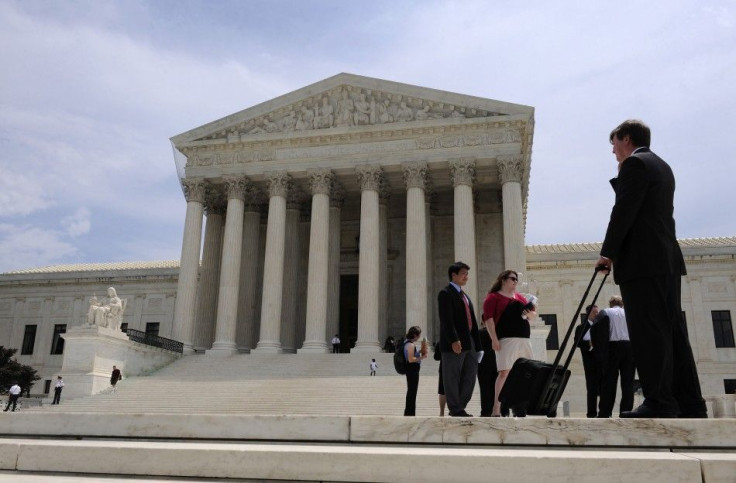Obama and the Courts, by the Numbers

President Barack Obama's picks for the federal judiciary have run up against the kind of GOP obstruction in the Senate that sent a few packing. Even a senator from the president's own party tried to hold up a nomination to a federal appeals court.
The treatment of Obama's judicial picks led Sen. Chuck Schumer, D-N.Y., to blame Republicans for breaking the 2005 bipartisan Gang of 14 agreement on use of judicial filibusters after the president's nominee to the influential D.C. Circuit Court of Appeals, a stepping stone to the U.S. Supreme Court, was blocked.
But how bad is the atmosphere for Obama's judicial picks? A report from the Brookings Institute's Russell Wheeler released Friday breaks down the Obama administration's track record on the federal courts, by the numbers.
Getting on the Bench
The report showed that Obama has had a rough time getting his nominations through the Senate. His predecessors have confirmation rates for district court judges of 91 percent (George W. Bush), 87 percent (Bill Clinton), 94 percent (Ronald Reagan) and 91 percent (Jimmy Carter). Obama got 73 percent of his nominations confirmed.
Most of Obama's predecessors also had higher rates of circuit court confirmations too, from 71 to 91 percent, with Carter and Reagan being the most successful. For Obama, 67 percent of these nominees are now judges.
More Vacancies
Unlike Clinton and Bush, Obama has seen an uptick in the number of vacancies on the federal bench, which is already overextended, close to its breaking point, said an August report from the Constitutional Accountability Center.
District court vacancies--there are 677 judgeships in the U.S.--shot up to 65 from 41 under the president's first term so far, while circuit court vacancies ticked up by one. This is partly due to the amount of judges on the district court level taking senior status, a kind of semi-retirement that opens up their seat.
In Obama's first three years, 92 judges have taken senior status, compared to the roughly 70 judges who did so in the first three years of the Clinton administration and George W. Bush's first term.
Despite this opportunity to load up the court system with his picks, Obama seems to have taken his time in making nominations, though his pace has steadily increased, the report said.
With 133 district court nominations, Obama has made 32 fewer than Bush did at the same point in his administration and 46 fewer than Bill Clinton. The number of circuit court picks made by Obama stands at 37, which is more than Clinton made but a dozen fewer than Bush, despite the vacancies.
The Hold-Up
Once tapped for an open seat, these nominees must sit tight for the long haul. The confirmation process has gotten longer when looking at the amount of days it takes for Obama's record on getting judges on the bench stacked up against Bush and Clinton's nominees.
Clinton, on average, got his district court picks through the Senate in 68 days; his appellate picks, which typically demand more scrutiny, took 120 days.
For Bush, the wait more than doubled. Bush district court nominees on average spent 138 days going through confirmation, while his appellate court judges took nearly 300 days. The trend, for the most part, has continued throughout Obama's first term. The average confirmation process for a district court judge was 212 days; circuit court judges waited on average 245 days to be confirmed.
Furthermore, more than half of Obama-picked judges faced confirmations longer than 180 days, a far higher rate than Bush and Clinton-picked judges.
Wheeler says the prolonged confirmation process may have led the Obama administration to begin picking sitting judges to fill vacancies on the federal courts. Current judges on the state and federal bench made up slightly more than half of Obama's nominees, while there has been a decrease in the number of private practice lawyers tapped for the district courts.
It is a problem... for lawyers to put their practice into limbo because clients shy away from counsel who may not be in for the duration, Wheeler wrote. Confirmation is less of a sure thing, and the wait for a resolution can go on for many months.
Change in Faces
While the report notes a shift in the resume of Obama's judges, they are also the most diverse. Obama's goal to shake up the look of the court went beyond the historic nominations of Justice Sonia Sotomayor and Justice Elena Kagan, the fourth woman to serve on the high court.
Obama was the first president to tap more minorities for federal judgeships than his predecessors. White males, who had made up all of President Dwight Eisenhower's nominees, accounted for 38 percent of Obama's appointees.
Nearly half of confirmed judges appointed from the Obama administration are women; more than a fifth are African American; 11 percent are Hispanic; and 7 percent are Asian American--a far leap from the 1 percent of confirmed judges in each of the Bush and Clinton administrations. One judge recently earned the distinction of being the first openly-gay man to be confirmed to the bench.
It's not just about race, it's not just about gender, it's not just about experience, White House counsel Kathryn Ruemmler said in a New York Times report. We try to look at judges in a much more holistic way.
Correction: Justice Elena Kagan was described as the third woman to serve on the Supreme Court. She is the fourth. The error has been corrected.
--
© Copyright IBTimes 2024. All rights reserved.





















